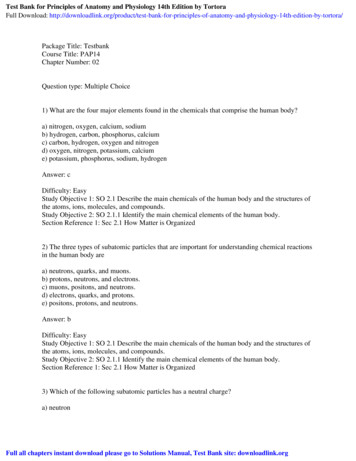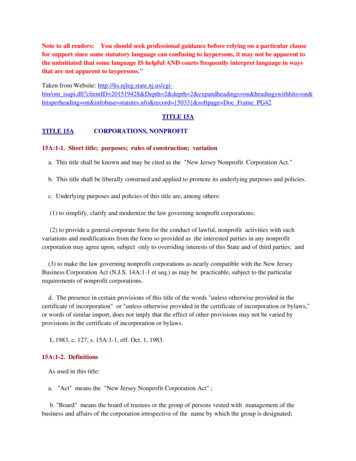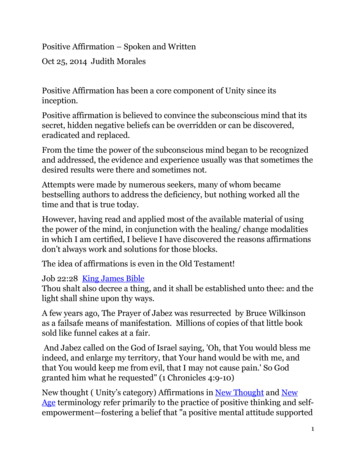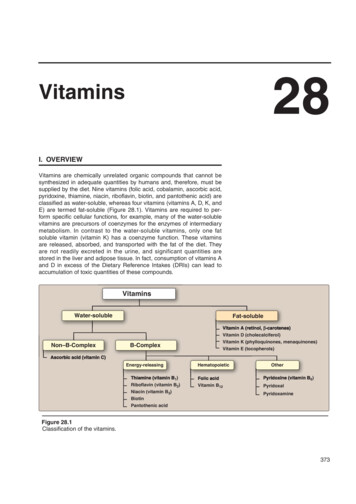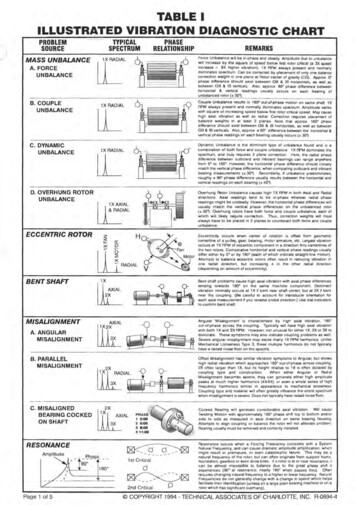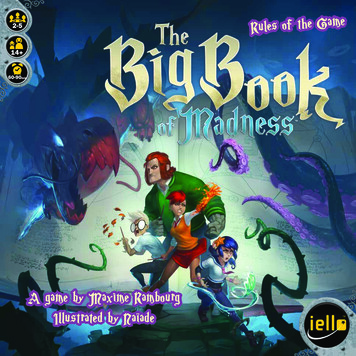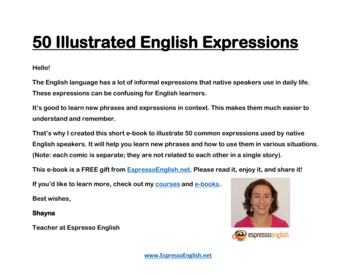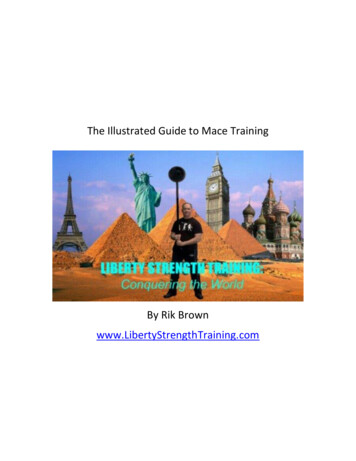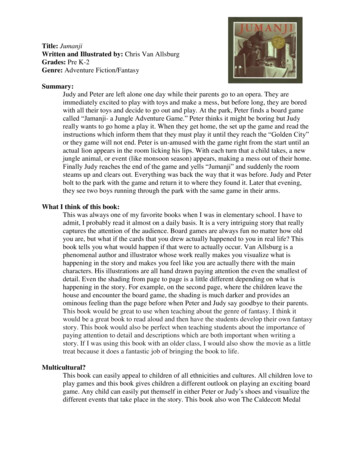
Transcription
Title: JumanjiWritten and Illustrated by: Chris Van AllsburgGrades: Pre K-2Genre: Adventure Fiction/FantasySummary:Judy and Peter are left alone one day while their parents go to an opera. They areimmediately excited to play with toys and make a mess, but before long, they are boredwith all their toys and decide to go out and play. At the park, Peter finds a board gamecalled “Jamanji- a Jungle Adventure Game.” Peter thinks it might be boring but Judyreally wants to go home a play it. When they get home, the set up the game and read theinstructions which inform them that they must play it until they reach the “Golden City”or they game will not end. Peter is un-amused with the game right from the start until anactual lion appears in the room licking his lips. With each turn that a child takes, a newjungle animal, or event (like monsoon season) appears, making a mess out of their home.Finally Judy reaches the end of the game and yells “Jumanji” and suddenly the roomsteams up and clears out. Everything was back the way that it was before. Judy and Peterbolt to the park with the game and return it to where they found it. Later that evening,they see two boys running through the park with the same game in their arms.What I think of this book:This was always one of my favorite books when I was in elementary school. I have toadmit, I probably read it almost on a daily basis. It is a very intriguing story that reallycaptures the attention of the audience. Board games are always fun no matter how oldyou are, but what if the cards that you drew actually happened to you in real life? Thisbook tells you what would happen if that were to actually occur. Van Allsburg is aphenomenal author and illustrator whose work really makes you visualize what ishappening in the story and makes you feel like you are actually there with the maincharacters. His illustrations are all hand drawn paying attention the even the smallest ofdetail. Even the shading from page to page is a little different depending on what ishappening in the story. For example, on the second page, where the children leave thehouse and encounter the board game, the shading is much darker and provides anominous feeling than the page before when Peter and Judy say goodbye to their parents.This book would be great to use when teaching about the genre of fantasy. I think itwould be a great book to read aloud and then have the students develop their own fantasystory. This book would also be perfect when teaching students about the importance ofpaying attention to detail and descriptions which are both important when writing astory. If I was using this book with an older class, I would also show the movie as a littletreat because it does a fantastic job of bringing the book to life.Multicultural?This book can easily appeal to children of all ethnicities and cultures. All children love toplay games and this book gives children a different outlook on playing an exciting boardgame. Any child can easily put themself in either Peter or Judy’s shoes and visualize thedifferent events that take place in the story. This book also won The Caldecott Medal
which helps show how this book should be in every classroom library. I know without adoubt that it will be in my own!Resources to go along with this .teachingbooks.net/tb.cgi?tid 3714&a 1
Title: If you Decide to go to the MoonWritten by: Faith McNultyIllustrated by: Steven KelloggGrades: K-3Genre: Science Fiction/NonfictionSummary:This cute yet informative book follows a young boy who decides he is going to take a tripto the moon. He explains all the things you need to bring with you when going to themoon (space suit, air tanks, books, food) and how long it will take to get there (factualinformation like “the moon is 240,00 miles away” and “you will get there in two-and-ahalf days”). Teaches the reader about what the journey to the moon is like and how spaceis much different than earth (no clouds or rain). The narrator even gives the reader a funvisual about what it is like without gravity and how the dark patches on the moon werecreated. Finally the little boy makes it to the moon after his long journey in his spaceship. Walking on the moon is much different than on earth and the story contrasts the two(each step you take on the moon is five times as far as a step on earth). The young boyteaches us all about how much different the moon is from earth and makes the audiencesee what a great planet we live on. The boy even fixes the America Flag that was left onthe moon when man first set foot on the moon back in July 1969; it was knocked down.The boy heads back to his space ship and heads back home to Earth and promise that hewill always do his best to protect all the life on our beautiful planet.What I think of this book:I have never read this book before and I have to say it is definitely one of my favorites! Ilearned so much more about the moon. Facts that I never learned when I was in schoolwhich is such a shame! Not only does the book present factual information about themoon and what you would need to do if you yourself were taking a trip there, but theillustrations are outstanding! Steven Kellogg did a fantastic job paining colorful andbright pictures of this boy’s journey to the moon. The colors and details of each pagereally capture the attention of the reader and make McNulty’s words come to life. Thisbook should definitely be read during any lesson/unit about the moon, no matter whatgrade level. This book would be a great recommendation for readers who enjoy booksabout space travel and the moon. The book would be good to use when teaching a classabout comparing and contrasting. The story also shows children that we live on abeautiful planet and although they may have dreams of traveling to the moon, they willmost certainly be excited to return back home.Multicultural?This book will easily capture the attention of any child no matter what ethnicity orculture. Young children are usually very fascinated by the moon and always havequestions to ask about it. This book will address basically every question that a child mayhave when it comes to traveling to the moon. Having a young child as the main charactermakes the story easy for children to relate to and allows them to put themselves in hisshoes and think about what would happen if they ever had the chance to travel to the
moon. This book should definitely be used when teaching any grade level about the moonand should be placed in every classroom library just like it will be in my own!Resources to go along with this g-946.html?tab ns%20K-2.docwww.nasa.gov/pdf/326863main Moon Munchies Lesson book-activities-and-lesson/
Title: Duck for PresidentWritten by: Doreen CroninIllustrated by: Betsy LewinGrades: K-2Genre: Fiction/Comedy and HumorSummary:Running a farm is very difficult for Farmer Brown. At the end of the day he is coveredfrom head to toe in dirt, hay, feathers, etc and he does not smell good at all. All the animalson the farm have their own chores to do too (pigs clean under the beds, cows weed thegarden, sheep sweep the barn, ducks take out the trash, mow the lawn, and grind coffeebeans). The animals are covered from head to toe with dirt and sweat from their day ofwork, just like farmer Brown. Duck does not like to be dirty from the day's work andbegins to wonder why Farmer Brown is in charge of the farm. He decides that the farmneeds to have an election! Duck begins to post campaign signs around the farm- "Vote forDuck! For a kinder Gentler Farm". Seeing this did not make Farmer Brown happy,especially when he went to the barn and found the animals registering to vote.Election Day comes around and all the animals fill out a ballot. The votes were counted andthe results were posted- Farmer Brown 6, Duck 20. Farmer Brown demanded a recount andan extra ballot was found stuck to the bottom of a pig. The new tally was Farmer Brown 6,Duck 21. Duck was now officially in charge! But Duck discovers that running a farm isVERY hard work and wasn't as fun as he thought it might be. That night, Duck and hisstaff begin to work on Duck's campaign for governor. He visited small-town diners,marched in parades, went to town meetings, and gave speeches that only other ducks couldunderstand. The voters filled out their ballots and Duck won by 1 vote! The governordemanded a recount and extra ballots were found under a plate of sticky pancakes. Duckstill had the most votes (by 3) and he was officially in charge.But little did Duck know, running a state is actually very hard. He decides to run forpresident of the US. He kissed babies in local diners, rode in parades, gave speeches thatonly ducks could understand, and even played saxophone on late-night television. ElectionDay comes around and CNN announces that Duck won by 5 votes. Of course the presidentdemanded a recount and there was some sticky ballots stuck to the vice president's bottom.Duck still won by 15 votes. Duck soon begins to find out that running a country is veryhard work. At the end of the day he was covered from head to toe in face powder, papercuts, staples, security badges, etc. He began to check the help wanted ads where he seesthat a duck is wanted to mow the lawn and grind coffee beans. He leaves the vice presidentin charge and goes back to the farm where he begins to work on his very ownautobiography.What I think of this book:Overall, this is a really cute story that would be perfect to use in any classroom duringelection time. The story teaches students about the leaders of a city, state, and country andall the hard work that they do. This book displays many of the elements of our governmentand would be a great way to introduce a lesson/unit on US government. Also shows and
explains the basics of an election in a way that young students can understand with greatillustrations as well.Multicultural?This book would definitely appeal to children of all ethnicities and cultures. The use offarm animals as the characters helps make this book fun and entertaining for all children.Perhaps students could even pick other animals they would like to see run for president,and focus on the qualities that animal has to make them a good president as a project to goalong with this book. Definitely a book I will be placing in my classroom.Resources to go along with this 1930219/
Title: Martha SpeaksWritten and Illustrated by: Susan MessaughGrades: Grades K-2Genre: Fiction/HumorSummary:Little girl Helen gives her dog Martha her alphabet soup, but the letters in the soup went toMartha's brain instead of her stomach. Suddenly Martha could actually talk and her familyimmediately had lots of questions; Martha had so much to tell them! "Have you alwaysunderstood us?", "You people are so bossy. Come! Sit! Stay! You never say please.", "Whydo you drink out of the toilet?" Alphabet soup became a regular part of Martha's diet andthe family loved surprising the neighborhood when walking Martha. Martha even learnedhow to use the phone, but teaching her how to do that was a huge mistake! She called toorder more than just pizza, she even ordered meat from "Acme Meat Company". Peoplealways doubted a talking dog, but Martha always gave the last word on that. But a problemstarted to occur, Martha always spoke her mind; "Why is that man so fat?” She madeembarrassing comments and always told the truth. The family started to get very mad butMartha never understood why. She spoiled TV shows, talked when the family tried to read,and just always talked and talked until finally her family just couldn't stand it anymore!"Martha, please! SHUT UP!"- Martha was crushed. For days Martha lied under the tableand never said anything. Helen's father even called the vet! She also lost her appetite foralphabet soup. But one day a burglar broke into the house. Martha tried calling the police,but she couldn't speak anymore! The burglar gave her some soup to distract her from hiswork. Finally Martha could speak again so she called the police! The burglar was caughtshe saved the day! Alphabet soup became a regular part of her diet again and Marthalearned when it was okay to speak and was even quiet sometimes! Well, at least for a fewminutes anyways!What I think of this book:This was one of my favorite books when I was in elementary school. This book easily canmake both children and adults smile and the detailed water color illustrations really capturethe attention of the audience (especially young children). This book also delivers a lifelongmessage that is perfect for children of all ages- communication is important, but you needto learn how/ where to use it.Multicultural?This book would definitely appeal to children of all ethnicities and cultures. Basically anychild could relate to this book because the main character is an animal. Children caneasily picture this story happening to their dog or pet. I know I did! Even if they do nothave a pet, this book will still capture the attention of the child and make them laugh.Definitely a book I will be placing in my classroom.Resource to go along with this etMarthaSpeaksCerealBowl.htm
Title: Mama, Do You Love Me?Written by: Barbara M. JoosseIllustrated by: Barbara LavalleeGrade Level: PreK-2Genre: Q&A/Fiction/MulticulturalSummary:The main characters in this book are an Eskimo/Inuit mother and daughter. The daughterbeing young and curious wonders if her mother loves her. She asks her mother a varietyof questions like how muc
Finally Judy reaches the end of the game and yells “Jumanji” and suddenly the room steams up and clears out. Everything was back the way that it was before. Judy and Peter bolt to the park with the game and return it to where they found it. Later that evening, they see two boys running through the park with the same game in their arms. What I think of this book: This was always one of my .
